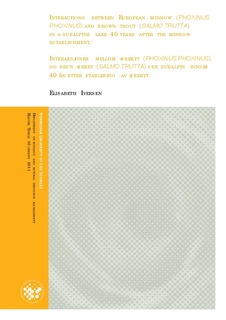| dc.description.abstract | The aim of this study is to clarify the interaction between European minnow (Phoxinus phoxinus) and brown trout (Salmo trutta), in the subalpine lake, Øvre Heimdalsvatn, with special emphasis on habitat use and diet between the two species about 40 years after the establishment of minnows in the lake. The fieldwork was carried out in three periods: June-July, July-August and August-September 2009. Nordic gillnets were used for collecting fish and to study the habitat use at four different depths (0.5 m, 1.5 m, 3 m and 6 m) in the littoral zone.
The results indicate a clear segregation in habitat use between the European minnow and brown trout. Most of the European minnows were captured at the shallowest depth, i.e. 0.5 m depth, whereas the majority of European minnow, regardless of depth, were captured at the lowermost section, 0-25 cm from the bottom. Few brown trout were captured compared to European minnow, but most brown trout was captured at 1.5 m depth and within the whole gillnet height. However, there was a clear trend towards higher catches in the two deepest sections, 0-25 and 25-50 cm.
Catches by electrofishing revealed that small European minnows, not captured by the gillnets, were frequent in the shallowest part of the littoral. Brown trout caught at deeper depths (3 and 6 m) had a larger body length (> 20 cm), than brown trout caught at 0.5 m and 1.5 m depths (< 20 cm).
The European minnow and juvenile brown trout (< 20 cm) forage mostly on the same prey organisms i.e. Cladocera, terrestrial insects, Ephemeroptera-, Plecoptera- and Trichoptera -species, Gammarus and chironomids. Additionally, juvenile brown trout foraged on European minnow, especially in the last period, where 28.9 volume % of the juvenile brown trout’s diet was minnow. In June-July there was a significant diet overlap (D = 63.6 %), whereas there was no significant diet overlap in the two other periods (D = 52.2 % and 42.5 %).
These results indicate a considerable interaction between brown trout and European minnow in Øvre Heimdalsvatn regarding both habitat use and diet. The large density of European minnow on shallow water may be a result of predation risk from brown trout. At the same time, the high European minnow density may strongly reduce available invertebrate prey for juvenile brown trout, which may seek to deeper water, where predation risk for small individuals may be higher. These interactions may lead to a reduced growth rate in brown trout due to reduced food availability, but also result in reduced recruitment to the harvestable stock because of predation on juvenile brown trout by larger brown trout. European minnow in high altitude lakes like Øvre Heimdalsvatn may thus reduce the catch potential of brown trout. | en_US |
